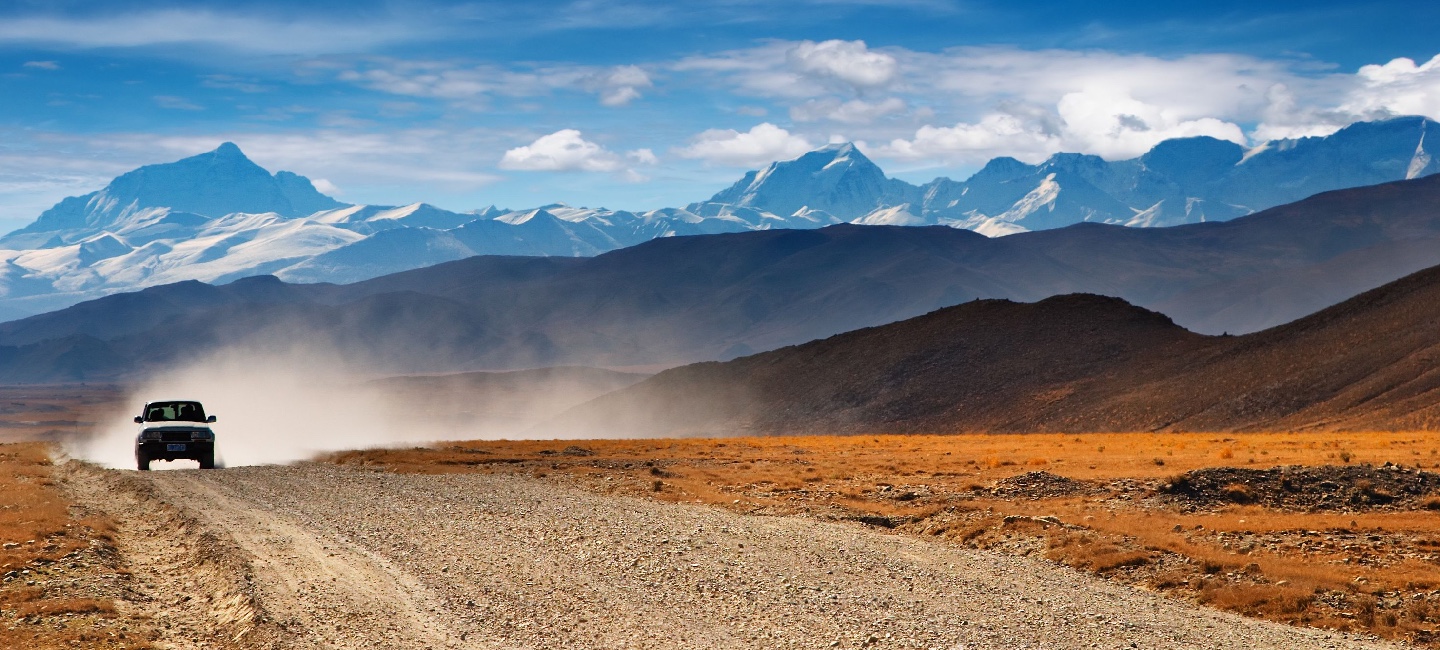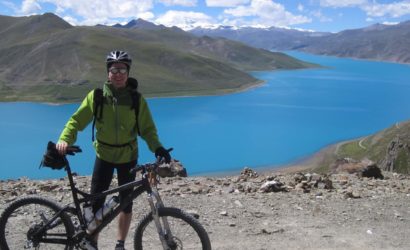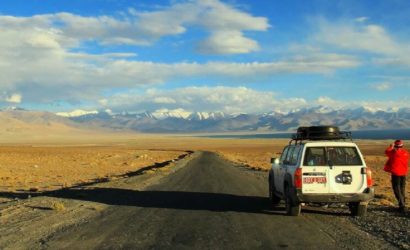Tibet Overland Tour Everest Base Camp is amazing tour in the Tibet. Start your journey to Tibet with a spectacular flight over the snow capped Himalayan Mountains Mt Kanchenjunga (8586 meters), Mt Everest (8848 meters) Mt Makalu (8463 meters) and others, spending 3 nights in Lhasa, staying right in the centre of the old city.
This will allow us plenty of time for acclimatization and easy access to the city’s main attractions – including Jokhang Temple and the monumental Potala palace of Kings and Dalai Lamas, with its various chapels along with unforgettable rooftop views of the holy city.
The Autonomous Region of Tibet is located in southwestern China and on the Qinghai-Tibet Plateau. The region covers an area of approximately 1.22 million km2, covering 12.8% of China’s total area. Taking a trip from Lhasa to Kathmandu is the best way to understand and explore Tibet. Tibet is without question a world apart, long considered a land of mystery and wonder, harsh and exquisitely beautiful.
The Tibet Overland tour Everest base camp, Leaving Lhasa in our 4 wheel drive, we’ll travel through this amazing country, staying in the best traditional hotels Tibet has to offer. Thoroughly exploring the towns of Gyantse and Shigatse we visit traditional monasteries and fully immerse ourselves in the Buddhist culture.
Along the Highway we travel through some of the most amazing landscapes on Earth. We pass small Tibetan settlements, nomadic herdsmen wandering across the wide arid plains and awe-inspiring mountain peaks.
Equally as fascinating is the wealth of cultural interest and there is plenty of opportunity to explore this side of Tibet, both in Lhasa and the other towns we pass through on our journey back to Kathmandu.
Upon your arrival in the Kathmandu airport after completing your custom formalities Visa, etc. pick up your luggage and look for our airport representative from Himalaya Discovery, who will display your name on the board at the arrival gate.
You will be greeted by our representative and transferred to the hotel by private tourist vehicle. Overnight in Kathmandu.
Today is free for sightseeing in Kathmandu. You may wish to visit Durbar Square in the heart of the old city where the old Royal Palace, with its intricate woodcarving is located.
The whole area is a maze of temples and images. Leading away from the square in all directions are narrow alleys, full of the most amazing variety of shops and stalls.
Some of these landmarks are considered World Heritage Sites including the historic Bhaktapur Durbar Square, the famous ‘Monkey Temple’ Swayambhunath and Buddhists shrine Buddhanath which is one of the largest Stupas in the world.
There will also be a full trip briefing today with gear check. In case you need to hire or buy equipment locally there will be time to do this today. Overnight at hotel in Kathmandu.
Early morning transfer to the international airport for the hour-long flight to Lhasa. This stunning flight, on a China Southwest Airlines Boeing 757, takes us right across the main Himalayan range and provides us with magnificent mountain views.
After landing at Gongar Airport and meeting our Tibetan guide, it is a further 2-hour drive by Land cruiser to Lhasa. It’s advisable to rest and take it easy for the remainder of the day due to Lhasa’s altitude. Overnight at hotel.
We spend today visiting several of Lhasa’s many monasteries in the company of a guide and interpreter. One of these is the Sera Monastery, one of the best-preserved monasteries in Tibet, within its whitewashed walls and golden roofs, several hundred monks live and study.
After lunch we’ll visit the Norbulingka, the summer palace of the Dalai Lama, as well as the Jokhang Temple. This temple is possibly the most sacred shrine in Tibet and there is always a procession of devout Tibetans through the complex.
Surrounding the Jokhang is the Barkor – a maze of narrow cobbled streets that is the central market of Lhasa. Overnight at hotel.
In the morning, we visit Potala Palace which dominates the city of Lhasa it’s a spectacular building, containing private quarters of the Dalai Lama as well as numerous grand state rooms and many important chapels.
There has been a Palace on this site since the 5th or 6th century, but the present Palace was constructed in the 17th century. After lunch, we visit the Drepung Monastery, which was founded in the 14th century and was once the largest in the world, with a population of around 10,000 monks.
These days that figure is down to several hundred, but there is still much here of interest as it was left relatively unscathed during the Cultural Revolution. Overnight at hotel.
The day begins with our overland journey towards Rongbuk valley. We follow the Friendship Highway by jeep, we cross the Khamba La at elevation of 4794 meters from which there are stunning views across the waters of Yamdrok-tso Lake to the snowy summit of Nazin Kang Sa 7252 meters.
As we continue our journey to westwards over another high pass the Karo La 5045 meters, we can view the spectacular sight of a huge glacier tumbling down to within a few hundred meters of the road.
After few hours, we arrive to Gyantse passing the beautiful valleys and colourful Tibetan villages. Overnight at hotel.
This morning we visit the Gyantse Dzong. This fort dates back to the fourteenth century and offers some of the most amazing views of Gyantse and surrounding valleys.
Before leaving we also visit the famed Gyantse Kumbum. This magnificent tiered structure is the largest stupa in all of Tibet. If the exquisite gold dome is not enough, this stupa is packed with Tibetan sculptures and paintings.
Thereby, we continue the trip to Shigatse, the second largest city in Tibet. It is only about a 90 km drive taking us to Shigatse which is a laid back city that provides excellent opportunity for both relaxation and discovery.
Thereafter, exploring the local market we will make a detailed visit to the Tashilhunpo Monastery, one of the largest functioning monasteries in Tibet. Overnight at hotel.
The views of this desert plateau provide wondrous entertainment as we travel along the Friendship Highway. This stretch is the most spectacular landscape in Tibet.
After passing through the small town of Lhatse we will cross Gyatmso La elevation of 5220 meters, the highest pass on our journey. The land quickly descends to plains after Gyatmso La.
While travelling through the plains we will see many nomadic herders, quiet countryside, and secluded monasteries. Overnight at hotel.
As we leave Shigatse, we turn off the Friendship Highway and head south over the Pang La 5150 meters towards the main Himalayan range that give magnificent view stretching from Makalu to Shishapangma.
Below the pass, as we turn the corner into the Rongbuk Valley, we can watch the charming view of Everest than ever. Overnight at hotel.
A highlight of the journey for everyone today as you have the opportunity to explore Everest Base camp. The views of Everest are so close making the mountain seem even more impressive than before.
It is a truly breathtaking experience to stare up at the sheer North face of this highest mountain in the world, with Mount Everest towering above you in a looming yet magical way.
After Lunch we get back on Friendship highway and continue our marvellous journey. Overnight at hotel.
After we leave Tingri, crossing two high passes, Lalung La at altitude of 5124meters and the Shung La 5200meters. On the way, we are rewarded by the magnificent landscapes of the surrounding peaks including Shishapangma, Cho Oyu, Menlungtse and Gauri Shankar. Then our journey heads towards the arid Tibetan Plateau to Zhangmu on the Nepalese border. As we leave Tibet, it appears an incredibly lush and green. Overnight at hotel.
Leaving Zhangmu behind, we join the Friendship Bridge passing the Bhote Koshi River and mark the Chinese – Nepalese border. After that short drive, we say good-bye to our Tibetan guide.
Then we drive and walk to Nepalese Immigration control in Kodari, there we have our Himalaya Discovery Adventures staff, completing the re-entry formalities we’ll drive towards Kathmandu, which may take 5 hours, it depends on road & weather conditions. Overnight at hotel in Kathmandu.
Today is rest and relax throughout the day. If you get interested to take some gifts from Nepal for friends and relatives, visit to some nearby shops or go out in Thamel for typical Nepalese goods which can be assisted by our guide or you can do it yourself too.
In the evening we will have a farewell dinner in a traditional Nepalese restaurant with cultural performances. Overnight in Kathmandu.
The trip concludes! our airport representative will drop you to the airport for your flight departure from Nepal.






